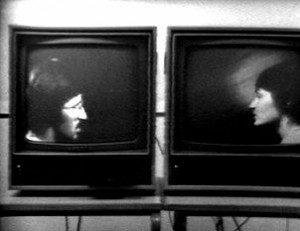Short Histories of Video Art
Short Histories of Video Art: 1965-present, John Hansard Gallery, Southampton, 11-15 May 2004.
Chris Meigh-Andrews, Continuum, (UK, 1977.)
I like to make works which operate between the flat screen (the monitor and the projected image) and the physical space within the gallery. I am interested in setting up a tension between illusory space (within the frame of the screen) and real, physical, architectural space. (Meigh-Andrews)
Early British video art differs from its American counterpart and British experimental film in that it is concerned less with identifying the specific properties of the medium than with analysing the conditions of viewing and the mechanics and shaping of perceptual and social space. Continuum is a good example of this sort of work. Originally a two-screen piece made in collaboration with Gabrielle Bown, it plays out the difficulty two lovers have in communicating with each other whilst at the same time revealing the illusoriness of the space in which their relationship is constructed. A man and a woman each occupy a tv screen. The screens are set side by side and a pendulum visible behind each of the two characters, who face each other, swings between them, first one screen then the other. The dialogue between the two is one of mutual misunderstanding and misread intentions. However, the piece ends rather humorously, with that dialogue breaking down, as both agree that the conversation need not go on in this manner as to do so would be to satisfy only what the situation of their performing the piece demands of them. Laughing, the two both rise from their seats and, if we had not already realised, we see that the space and time each of them occupies is in fact only illusorily separate, or only illusorily shared. The question is why this sort of space should be considered to be ‘illusory’ at all: why is it not real or architectural? This points to an essential difference, perhaps, between contemporary art and modern art: contemporary artists are less inclined to accept the autonomy of the art work, and consider the move of ‘revealing’ the conditions of viewing to be no less a construct than that which is thereby ‘revealed’ to be a construct.
Jonathan Dronsfield
